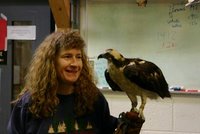
So what exactly do volunteers at the Rocky Mountain Raptor Program do? Well, here's a quick rundown of what goes down at a typical morning treatment:
- Initial bird check. Someone looks in all the bird flights (cages) and checks to make sure all the birds are accounted for, and appear to be alive. You never know what happens overnight.
- Pulling SOAPs. SOAP is an acronym for Subjective, Objective, Assessment, and Plan, and it is basically the official report and a record of all human interactions with the bird, and a description of how the bird is to be treated on a daily basis. This last part is also called the PPP, or Pre-Printed Plan. Some birds' PPP has them getting fed and having their cages cleaned in the morning, making them a so-called 'AM' bird, while others are 'PM' birds. Owls are generally PM birds while all others are 'AM', but exceptions occur.
- Food prep. Birds get fed fresh raw meat, usually prairie dogs (referred to in the center as p-dogs), mice, rats, and sometimes venison or red meat like deer or beef. Occasionally we get duck, goose, or turkey. Food prep involves determining how much each bird gets fed, and butchering however much it needs (as written in the PPP). This is usually the grossest part of the treatment - I make sure never to breath through my nose at this point. P-dogs are the worst.
- Cage cleaning. In the summer we can use hoses, but in the winter we have to use water buckets. Because the cages are outside, standing water can freeze, so we have to reduce the overall water usage that time of year, while still cleaning as much as possible.
- Meds. While the cage cleaning is happening, an "M1" or medical volunteer begins going through whatever specific regular medical treatments that certain active case birds require, like applying topicals, injecting fluids, inspecting wounds, etc.
- Food drop. This occurs after a cage is fully cleaned, and is usually done by the same person. The food is left on a small mat or other surface. Water in the bowl is also replaced.
- Special handling birds. These are usually educational birds, the nonreleaseables that are now trained to make public appearances. It also includes nonreleaseables in training, or other special cases which regular 'H' level volunteers are not allowed to be close to, for whatever reason. Sometimes it's because the bird is especially afraid of humans, other times it's because the bird has delicate bandaging on its wings or elsewhere, and needs to be closely monitored by professionals to make sure they don't get damaged.
This also includes the educational birds that have to get fed on the fist. In this case, a qualified 'E1' or ed bird handler can take the bird out its flight, fully jessed (leashed), and personally feed the bird.
- Cleanup. All the aforementioned usually creates a mess in the main treatment room, so we do sweeping, mopping, utensil cleaning, and garbage removal. There's also the nasty bit called 'necropsy', in which biomaterials like uneaten food, feather clumps, and discarded butchering remains have to be disposed of properly.
- Final bird check. This ensures that all the birds have water, are where they should be, etc., before all us humans go off and do our thing.
 Depending on the active case load and how many volunteers are helping in a session, this can take anywhere from 2 to 4 hours. Winter is usually quicker, due to a smaller case load, despite the slowness of bucket cleaning. Summer can be extremely busy, and if only a few volunteers are present for a treatment, it can take up to 7 hours to finish, like it did for a couple times last July.
Depending on the active case load and how many volunteers are helping in a session, this can take anywhere from 2 to 4 hours. Winter is usually quicker, due to a smaller case load, despite the slowness of bucket cleaning. Summer can be extremely busy, and if only a few volunteers are present for a treatment, it can take up to 7 hours to finish, like it did for a couple times last July.tags: birds raptors rehabilitation

No comments:
Post a Comment